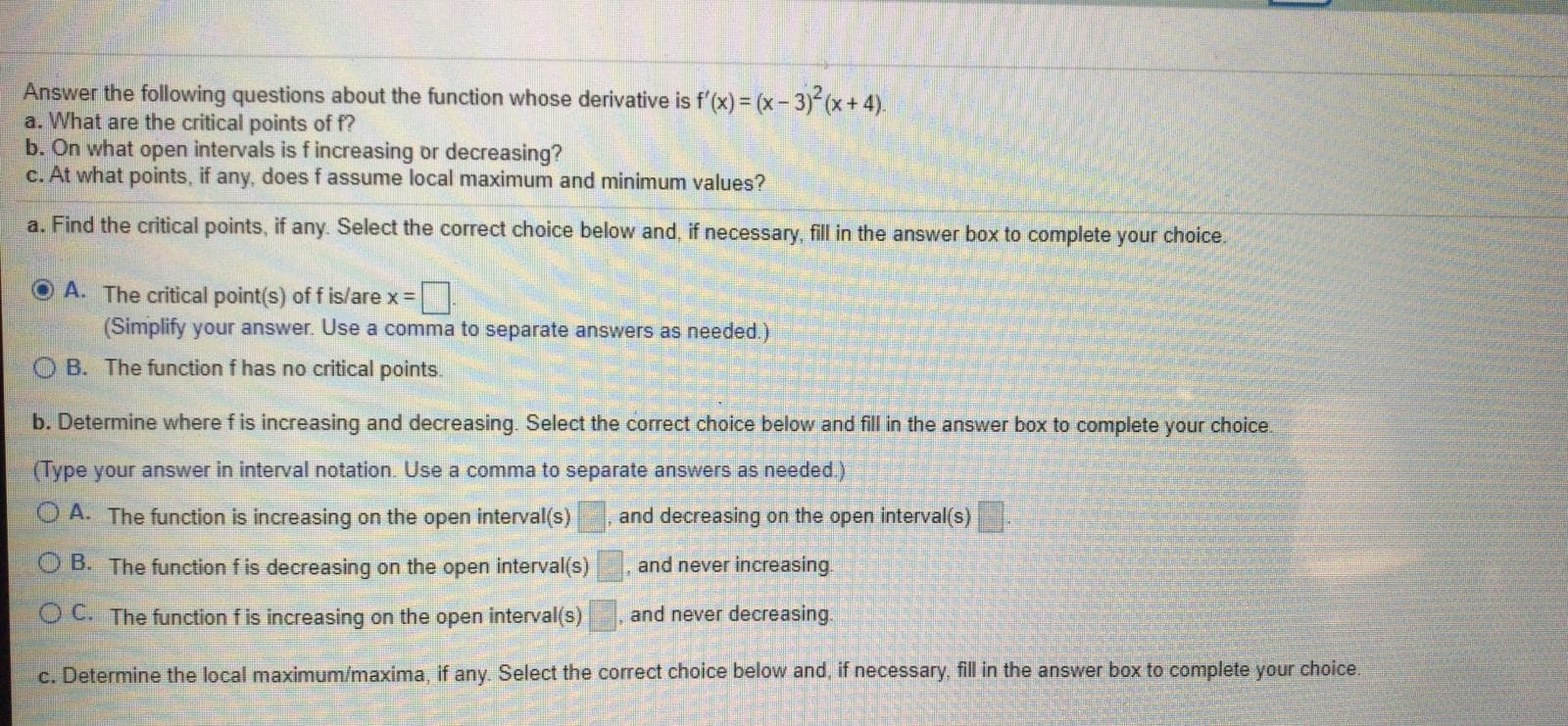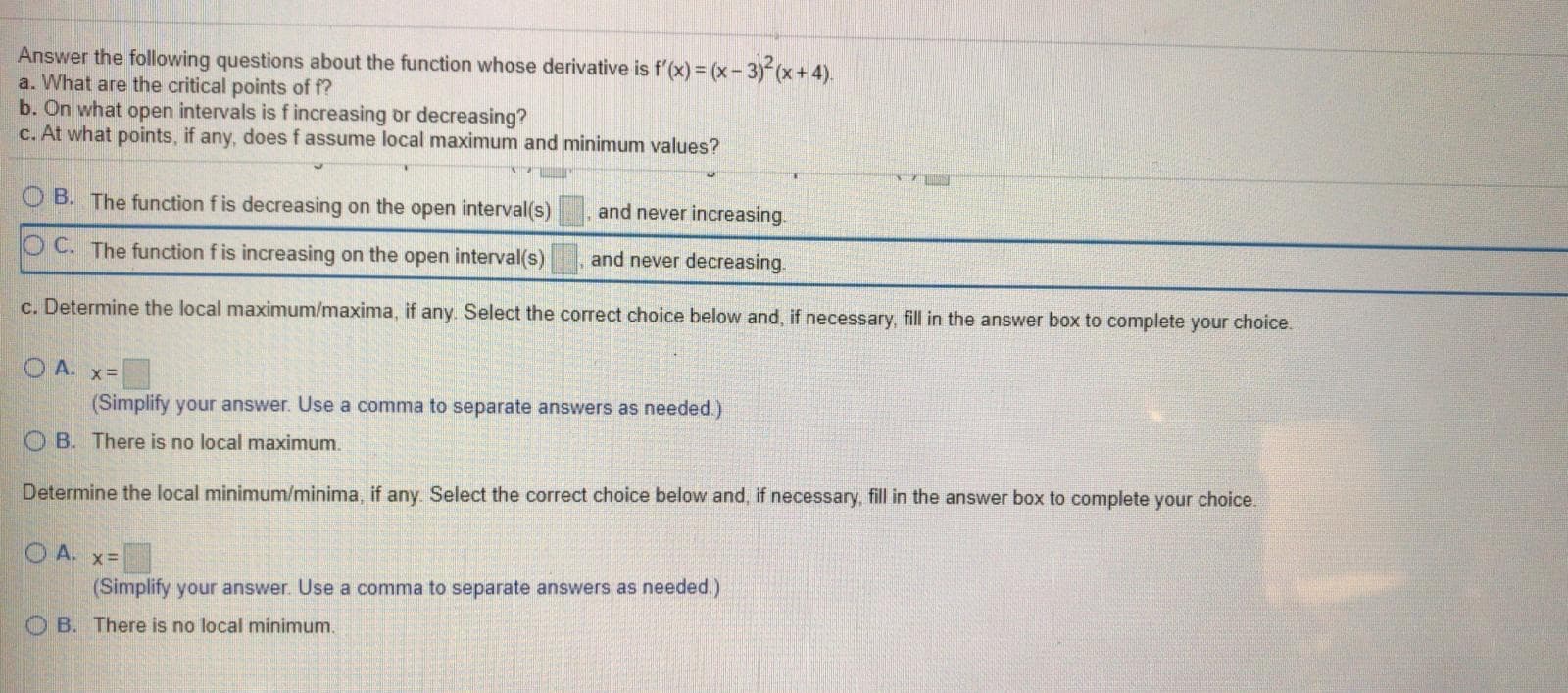Answer the following questions about the function whose derivative is f'(x) = (x-3) (x+ 4). a. What are the critical points of f? b. On what open intervals is fincreasing or decreasing? c. At what points, if any, does f assume local maximum and minimum values? a. Find the critical points, if any. Select the correct choice below and, if necessary, fill in the answer box to complete your choice. O A. The critical point(s) of f is/are x = (Simplify your answer. Use a comma to separate answers as needed.) O B. The function f has no critical points. b. Determine where f is increasing and decreasing. Select the correct choice below and fill in the answer box to complete your choice. (Type your answer in interval notation. Use a comma to separate answers as needed.) A. The function is increasing on the open interval(s) and decreasing on the open interval(s) O B. The function f is decreasing on the open interval(s) and never increasing. O C. The function f is increasing on the open interval(s) and never decreasing. c. Determine the local maximum/maxima, if any. Select the correct choice below and, if necessary, fill in the answer box to complete your choice. Answer the following questions about the function whose derivative is f'(x) = (x- 3) (x+ 4). a. What are the critical points of f? b. On what open intervals is f increasing or decreasing? c. At what points, if any, does f assume local maximum and minimum values? O B. The function f is decreasing on the open interval(s) and never increasing. O C. The function f is increasing on the open interval(s) and never decreasing. c. Determine the local maximum/maxima, if any. Select the correct choice below and, if necessary, fill in the answer box to complete your choice. O A. x= (Simplify your answer. Use a comma to separate answers as needed.) O B. There is no local maximum. Determine the local minimum/minima, if any. Select the correct choice below and, if necessary, fill in the answer box to complete your choice. O A. x= (Simplify your answer. Use a comma to separate answers as needed.) O B. There is no local minimum.
Answer the following questions about the function whose derivative is f'(x) = (x-3) (x+ 4). a. What are the critical points of f? b. On what open intervals is fincreasing or decreasing? c. At what points, if any, does f assume local maximum and minimum values? a. Find the critical points, if any. Select the correct choice below and, if necessary, fill in the answer box to complete your choice. O A. The critical point(s) of f is/are x = (Simplify your answer. Use a comma to separate answers as needed.) O B. The function f has no critical points. b. Determine where f is increasing and decreasing. Select the correct choice below and fill in the answer box to complete your choice. (Type your answer in interval notation. Use a comma to separate answers as needed.) A. The function is increasing on the open interval(s) and decreasing on the open interval(s) O B. The function f is decreasing on the open interval(s) and never increasing. O C. The function f is increasing on the open interval(s) and never decreasing. c. Determine the local maximum/maxima, if any. Select the correct choice below and, if necessary, fill in the answer box to complete your choice. Answer the following questions about the function whose derivative is f'(x) = (x- 3) (x+ 4). a. What are the critical points of f? b. On what open intervals is f increasing or decreasing? c. At what points, if any, does f assume local maximum and minimum values? O B. The function f is decreasing on the open interval(s) and never increasing. O C. The function f is increasing on the open interval(s) and never decreasing. c. Determine the local maximum/maxima, if any. Select the correct choice below and, if necessary, fill in the answer box to complete your choice. O A. x= (Simplify your answer. Use a comma to separate answers as needed.) O B. There is no local maximum. Determine the local minimum/minima, if any. Select the correct choice below and, if necessary, fill in the answer box to complete your choice. O A. x= (Simplify your answer. Use a comma to separate answers as needed.) O B. There is no local minimum.
College Algebra (MindTap Course List)
12th Edition
ISBN:9781305652231
Author:R. David Gustafson, Jeff Hughes
Publisher:R. David Gustafson, Jeff Hughes
Chapter3: Functions
Section3.3: More On Functions; Piecewise-defined Functions
Problem 99E: Determine if the statemment is true or false. If the statement is false, then correct it and make it...
Related questions
Topic Video
Question
100%
one question but could not fit all in one picture.

Transcribed Image Text:Answer the following questions about the function whose derivative is f'(x) = (x-3) (x+ 4).
a. What are the critical points of f?
b. On what open intervals is fincreasing or decreasing?
c. At what points, if any, does f assume local maximum and minimum values?
a. Find the critical points, if any. Select the correct choice below and, if necessary, fill in the answer box to complete your choice.
O A. The critical point(s) of f is/are x =
(Simplify your answer. Use a comma to separate answers as needed.)
O B. The function f has no critical points.
b. Determine where f is increasing and decreasing. Select the correct choice below and fill in the answer box to complete your choice.
(Type your answer in interval notation. Use a comma to separate answers as needed.)
A. The function is increasing on the open interval(s)
and decreasing on the open interval(s)
O B. The function f is decreasing on the open interval(s)
and never increasing.
O C. The function f is increasing on the open interval(s)
and never decreasing.
c. Determine the local maximum/maxima, if any. Select the correct choice below and, if necessary, fill in the answer box to complete your choice.

Transcribed Image Text:Answer the following questions about the function whose derivative is f'(x) = (x- 3) (x+ 4).
a. What are the critical points of f?
b. On what open intervals is f increasing or decreasing?
c. At what points, if any, does f assume local maximum and minimum values?
O B. The function f is decreasing on the open interval(s)
and never increasing.
O C. The function f is increasing on the open interval(s)
and never decreasing.
c. Determine the local maximum/maxima, if any. Select the correct choice below and, if necessary, fill in the answer box to complete your choice.
O A. x=
(Simplify your answer. Use a comma to separate answers as needed.)
O B. There is no local maximum.
Determine the local minimum/minima, if any. Select the correct choice below and, if necessary, fill in the answer box to complete your choice.
O A. x=
(Simplify your answer. Use a comma to separate answers as needed.)
O B. There is no local minimum.
Expert Solution
This question has been solved!
Explore an expertly crafted, step-by-step solution for a thorough understanding of key concepts.
This is a popular solution!
Trending now
This is a popular solution!
Step by step
Solved in 3 steps with 2 images

Knowledge Booster
Learn more about
Need a deep-dive on the concept behind this application? Look no further. Learn more about this topic, calculus and related others by exploring similar questions and additional content below.Recommended textbooks for you

College Algebra (MindTap Course List)
Algebra
ISBN:
9781305652231
Author:
R. David Gustafson, Jeff Hughes
Publisher:
Cengage Learning

College Algebra (MindTap Course List)
Algebra
ISBN:
9781305652231
Author:
R. David Gustafson, Jeff Hughes
Publisher:
Cengage Learning